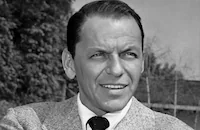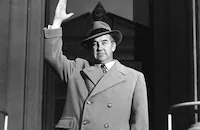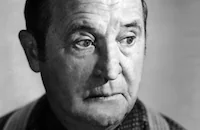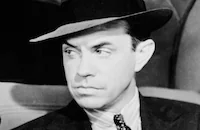Not As a Stranger

Brief Synopsis
Cast & Crew
Stanley Kramer
Olivia De Havilland
Robert Mitchum
Frank Sinatra
Gloria Grahame
Broderick Crawford
Film Details
Technical Specs

Synopsis
Lucas Marsh, an ambitious medical student who rigidly strives for perfection, desperately needs money for his tuition. Luke visits his alcoholic father Job, who has squandered the money that Luke's mother had saved for him. Hurt by Luke's scorn, Job tells him that he will never be a good doctor because "something was left out of him," leaving him with no empathy. Although Alfred Boone, a fellow student, and pathologist Dr. Aarons lend Luke some money, it is not enough. Aarons advises him to return to school after working for a year, but Luke is unwilling to postpone his education. With the borrowed money, Luke makes a partial payment, but is informed that, unless he pays the balance within thirty days, he will be expelled. Later, after Luke and Al watch an operation, shy, Swedish-American spinster Kristina Hedvigson, the head operating-room nurse, invites them to a smorgasbord the following weekend at the home of Swedish-American friends. There, Kris's friend Bruni, who knows that Kris has a crush on Luke, brags about Kris's thriftiness and reveals that she has saved several thousand dollars. The comments are not lost on Luke, who takes advantage of Kris's admiration for him by romancing her. Kris soon admits to Bruni that she is in love with Luke, although she is both worried by and attracted to his dedication to being a doctor. Soon after, Luke asks Kris to marry him, then informs her that he is about to leave school, prompting her to offer him the tuition money. He pretends to be proud and refuses the help, but then "relents." That night, Al accuses Luke of exploiting a woman who is afraid of becoming an old maid and of allowing himself to be kept. Luke insists that Kris will never learn that he does not love her, and Al agrees to be his best man, despite his further admonition that Kris is not sophisticated enough to be a doctor's wife. After Luke and Kris are married, he continues his studies with her help. One day, Luke publicly criticizes a surgeon, Dr. Dietrich, for failing to use a new, proven technique during surgery. Aarons is outraged by Luke's arrogant behavior and, although he admits that the surgeon was wrong, tells Luke that he will not be allowed to intern at the hospital unless he apologizes. Luke refuses to give in and implies to Kris that she is too stupid to understand his dogmatic view that a doctor must be perfect at all times. The following day, however, Luke reluctantly apologizes to Dietrich. Time passes, and after becoming interns, Luke and Al are on duty one night when an ambulance brings in the dead body of a man who fell under a bus. The dead man turns out to be Job, and Luke, showing emotion for the first time, cries for his father. Some time later, when Luke discovers that Al has carelessly removed a patient's mole that Luke had earlier recognized as a melanoma and refused to touch, he threatens to report the incident, but Al does so himself. Kris criticizes Luke for yelling at Al, his best friend, in front of others, but Al later admits that Luke was correct to reprimand him. After completing his internship, Luke takes a position in the small town of Greenville as assistant to general practitioner Dr. David W. Runkleman. Luke works hard and learns a great deal from the practical but compassionate Runkleman. Believing that it is time for them to start a family, Kris attempts to broach the subject to Luke, but he falls asleep while she is talking. Luke soon meets a wealthy and sophisticated young widow, Harriet Lang, who breeds horses, and is immediately attracted to her. The next morning, while testing a new stethoscope on Runkleman, Luke discovers what Runkleman has known for some time, that he has a serious heart condition. Luke advises him to retire, but he refuses. When they then perform an operation, Dr. Clem Snider, director of the local hospital who serves as the anaesthetist, almost causes the death of their patient. Later that night Runkleman tells Kris and the still-brooding Luke that Snider is a political appointee and cannot be replaced. During dinner, they meet Harriet and her lawyer, Ben Cosgrove. Luke gets into an argument with Cosgrove, and later, at home, argues with Kris because she drank too much and was jealous of his attentions to Harriet. Although Luke apologizes, Kris realizes that their marriage is crumbling and asks him again about starting a family, but Luke tells her that he is not ready. Later, despite Harriet's warning that she cannot afford to fall in love with Luke because he would have no time for her, they start an affair. Meanwhile, Kris goes to see Al, who confirms that she is twelve weeks pregnant. Kris reveals that she has not told Luke, and Al, who realizes what a wonderful wife Kris has been to Luke, advises her to do so. Later, at the hospital, Luke discovers that Mr. Carl Emmons, an elderly patient Snider has left to die quietly, has typhoid but can be saved. After Luke puts Emmons in isolation and threatens to kill the incompetent Snider, he asks Kris to help him and, together, they save Emmons. Genuinely admiring Kris's nursing abilities, Luke tells her that she should return to work and that a family is not for her. When Al comes to visit soon after and finds Kris alone because Runkleman and Luke are innoculating the townspeople against typhoid, he urges her to tell Luke about the baby. Meanwhile, Luke visits Harriet and tells her that he feels guilty and must end their relationship. When Luke returns home, Al is waiting outside and tells him about Kris's pregnancy. Stunned, Luke apologizes to Kris and asks for another chance, but, realizing that he has always used her, Kris angrily rejects him. Later, Runkleman collapses due to his heart condition and Luke operates immediately, ordering Snider to assist. They repair Runkleman's ruptured aorta, but when Luke attempts an added procedure, he makes a miscalculation that causes the aorta to rupture again and Runkleman dies. As Luke leaves the operating room, Snider says, "God help him, he made a mistake." Distraught, Luke walks through town and at last realizing his own humanity, returns home to Kris, who welcomes him with open arms and comforts him.

Director

Stanley Kramer
Cast

Olivia De Havilland

Robert Mitchum

Frank Sinatra

Gloria Grahame

Broderick Crawford

Charles Bickford

Myron Mccormick

Lon Chaney [jr.]

Jesse White

Harry Morgan

Lee Marvin
Virginia Christine

Whit Bissell
Jack Raine

Mae Clarke
William Vedder
John Dierkes

Jerry Paris

Will Wright

Carl "alfalfa" Switzer

Frank Orth
Harry Shannon
Frank Jenks

Paul Guilfoyle

King Donovan
Earle Hodgins
Nancy Kulp

Juanita Moore
Herb Vigran
Peggy Maley
Patti Brill
Eve Mcveagh
Crew
Harry Anderson
Edna Anhalt
Edward Anhalt
George Antheil
John E. Burch
Virginia Christine
Esperanza Corona
Carter Dehaven Jr.
Louis Dewitt
Josh Fields M.d.
John Franco
Victor Gangelin
Sally Hamilton
Buddy Kaye
Joe King
Fred Knudtson
Anne Kramer
Stanley Kramer
Marjorie Lefevre R.n.
Don Loper
Bud Mautino
Morton Maxwell M.d.
Harry Mines
Franz Planer
Jack Rabin
Howard Richmond
Morris Rosen
Paul Sawtell
Earl Snyder
Rudolph Sternad
James Van Heusen
Bill Wood

Photo Collections
Film Details
Technical Specs

Award Nominations
Best Sound
Best Sound Editing
Articles
Not as a Stranger
Not as a Stranger was filmed at the old Chaplin Studios on La Brea in Los Angeles with some additional shooting at various local hospitals such as the Birmingham Veterans Hospital in the San Fernando Valley. Since Kramer wanted the film to be as realistic as possible, he made sure that several scenes were devoted to authentic surgical procedures such as a gastrectomy and an actual autopsy that made some cast members flinch. But if life at the hospital looked pretty grim on camera, it was a decidedly different story off the set.
Robert Mitchum, Frank Sinatra, and Broderick Crawford immediately bonded during filming and formed a hard-drinking, hell-raising trio, playing practical jokes on Kramer and fellow cast members. They rearranged the props, mercilessly teased the medical advisers, and made suggestive remarks to their co-star Olivia de Havilland who took it all in stride. At one point, the "boys," with some help from Lee Marvin and Myron McCormick, staged a barroom brawl in the dressing rooms, smashing windows, breaking furniture, and ripping phones out of the wall. It all culminated with the 260-pound Broderick Crawford sailing off a second-floor balcony to the ground below with no discernable damage.
Although Not as a Stranger received mixed critical reviews upon its release, it did offer Sinatra a change of pace from the secondary romantic leads he had previously been playing in MGM musical comedies. It's true he was a little too old (he was almost forty at the time) to be playing a happy-go-lucky intern but he received better notices than his co-stars Robert Mitchum and Gloria Grahame. The former was taken to task for his dispassionate performance (although his character was supposed to be cold and impersonal) while Grahame was ridiculed for her final love scene with Mitchum, an unsubtle intercutting between close-ups of her erotic lips and a barnyard setting where a stallion cavorted amorously with a mare.
Director/Producer: Stanley Kramer
Screenplay: Edna Anhalt, Edward Anhalt, based on the novel by Morton Thompson
Cinematography: Franz Planer
Editor: Frederic Knudtson
Art Direction: Howard Richmond
Music: George Antheil
Cast: Olivia de Havilland (Kristina Hedvigson), Robert Mitchum (Lucas Marsh), Frank Sinatra (Alfred Boone), Gloria Grahame (Harriet Lang), Broderick Crawford (Dr. Aarons), Charles Bickford (Dr. Runkleman).
BW-137m.
by Jeff Stafford

Not as a Stranger
TCM Remembers - Stanley Kramer
With these films, Stanley Kramer built his reputation as a producer of important films. He made movies with a conscience, movies with a message. Although his films were sometimes criticized as being too simplistic in dealing with tough subjects, Kramer still deserves a great deal of credit for tackling sensitive subject matter no other director or studio wanted to address. His exploration of timely social issues is what makes his cinema unique and his recent passing leaves us with no one to fill his shoes.
Kramer learned his craft within Hollywood's studio system. He began as a production assistant on So Ends Our Night(1941) and was soon writing and editing. By the late forties, Kramer broke away from the studio hierarchy and formed an independent production company. Outside of the Hollywood system, he could tackle social issues head-on while producing well-crafted and meaningful dramas. In The New York Times obituary for Kramer, the director was quoted in accessing his own career and it's most appropriate here: "I decided that somewhere between the films on outer space and Sylvester Stallone, there is a place for me. I was always associated with films that had an opinion. I don't believe films change anyone's mind, but I was spawned during the Roosevelt era, a time of great change, and I still believe in trying to get people to think."
For his directorial debut, Not As A Stranger (1955), Kramer signed up the all-star cast of Robert Mitchum, Frank Sinatra, Olivia de Havilland and Gloria Grahame to reveal the trials and tribulations of doctors and nurses balancing medical school with their personal relationships. In The Defiant Ones (1958) shackled Tony Curtis and Sidney Poitier together as escaped convicts. As they flee the law they're forced to confront each other's racism and ultimately discover that beneath their skin color, they are not so different. On the Beach (1959) was Kramer's anti-atom bomb polemic in which Gregory Peck, Ava Gardner, Anthony Perkins and Fred Astaire survive an initial nuclear holocaust only to face a slow, painful death from fallout.
From the arms race to Biblical scripture, the following year Kramer turned his attention to the Scopes Monkey Trial of 1925 in Inherit the Wind(1960). This famous courtroom trial was a true-life clash of the titans as Fredric March and Spencer Tracy face off on the issue of Evolution versus Creationism. Although names are changed, March gave a grandstanding performance as William Jennings Bryan, the mouthpiece for conservatism, while Tracy played Clarence Darrow, a tireless fighter for progressive thought.
Kramer's films were more than just entertainment; his stories were political platforms for the Civil Rights Movement, disarmament and liberal thinking. For audiences who thought the director couldn't take on an issue greater than the Scopes Monkey Trial, Kramer's next film would prove to be even more controversial. Again, Kramer booked a cast of Hollywood's hottest names to bring mass appeal to his very serious film.
In Judgment at Nuremberg (1961) Spencer Tracy presides over a German war-criminal trial which delves into the atrocities of the Nazi regime. Burt Lancaster sits smugly on the stand as Ernst Janning, an unrepentant officer of the Gestapo, as Maximilian Schell mounts his defense. Montgomery Clift, as a Jew subjected to a sterilization experiment, nervously submits his testimony. Judy Garland and Marlene Dietrich each take the stand. Hollywood's greatest stars came out to shed light on one of the darkest moments of the 20th century. The Academy responded with 11 nominations, including for Best Picture, Director, Actor (Tracy), Supporting Actor (Clift), Supporting Actress (Garland), Adapted Screenplay, Cinematography and Editing. Schell won Best Actor for his dynamic performance as Herr Rolfe.
However, Stanley Kramer wasn't "Mr. Message Film" all the time. In a lighter moment, he produced the surrealist anti-fascist fantasy, The 5,000 Fingers of Dr. T(1953) in which he enlisted the talents of Dr. Seuss. More famously, he pooled the greatest comics together for an insane Cinerama screwball farce - It's a Mad, Mad, Mad, Mad World (1963).
By Jeremy Geltzer & Jeff Stafford
TCM Remembers - Stanley Kramer
Quotes
Trivia
Notes
The film's opening title cards read: "Stanley Kramer Pictures Corporation Presents A United Artists Release Morton Thompson's Not As a Stranger." Thompson died a few weeks before the publication of his novel. A Variety news item of February 3, 1954 revealed that producer Stanley Kramer made a pre-publication deal to purchase the screen rights in early December 1953 for $75,000. The novel subsequently became a bestseller. According to a May 20, 1954 Hollywood Reporter news item, Kramer followed the "same book-plugging campaign used on The Caine Mutiny" by visiting book editors in large cities and making personal appearances at bookstores in order to publicize the novel and create a larger audience for the film.
Not As a Stranger marked longtime producer Kramer's first film as a director. On February 17, 1954, Los Angeles Times reported that Kramer wanted Montgomery Clift for the role of "Lucas Marsh" and Ingrid Bergman for "Kristina Hedvigson." A September 21, 1954 Hollywood Reporter news item noted that Olivia de Havilland observed two surgical operations at Cedars-Sinai Hospital to prepare for her role. Although Hollywood Reporter news items add the following actors to the cast, their appearance in the completed film has not been confirmed: John Goddard, David Alpert, Tamar Cooper, Jo Gilbert, Stafford Repp, Darren Dublin, Tyler McVey, Israel Garcia, Lynn Kevin, Heidi Dublin, Mimi Doyle, Jo Anne Davis, John Raven, Gail Bonney, Marlo Dwyer, Michael Free, Stephen Wooton, Don C. Harvey, Gertrude W. Hoffman, Dave White, Susan Hamilton, Donald Kerr, Art Lewis, Dorothy Newmann, Claire Carleton, Kate McKenna, Alan Nixon, Jimmy Hawkins, Peggy Campbell, Pattee Chapman, Rankin Mansfield, Mack Williams, Richard Emory, Kay Stewart, Aloha Wray, Harry Lauter, Marlene Felton, John Lehman and Harlan Warde.
Buildings on the University of California, Los Angeles campus served as exteriors for the medical school. A November 5, 1954 Hollywood Reporter news item adds Whitman Air Field in the San Fernando Valley as another shooting location. According to an September 8, 1954 Hollywood Reporter news item, Dmitri Tiomkin was originally set to write and direct the film's music score but dropped out due to "conflicting commitments." Although James Van Heusen and Buddy Kaye are credited onscreen with the song "Not As a Stranger," and it was recorded by Frank Sinatra in 1955, only the instrumental version was used in the released picture. A January 20, 1955 Hollywood Reporter news item noted that Eddie Fisher was also scheduled to record the song. Sinatra's recording of the song was released in 1959 on his "Look to Your Heart" album.
On March 10, 1955, Hollywood Reporter reported that "the biggest ad, publicity and exploitation budget in United Artists' history"-at least $1,000,000-was to be spent publicizing the picture. Other Hollywood Reporter news items noted that a special five-minute trailer, featuring Kramer explaining the film's story and how the cast was selected, and showing clips of the stars's makeup tests and performances, was to be shown on television and in movie theaters. The film's West Coast premiere, held on June 28, 1955 in Los Angeles, raised over $30,000 for the new Mt. Sinai Hospital. Not As a Stranger received an Academy Award nomination for Best Sound Recording.

Miscellaneous Notes
Released in United States Summer July 1955
Released in United States Summer July 1955
Voted Best Supporting Actor (Bickford) and One of the Year's Ten Best Films by the 1957 National Board of Review.














